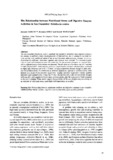The relationship between nutritional stress and digestive enzyme activities in sea cucumber Holothuria scabra
Share
Abstract
The sea cucumber Holothuria scabra (sandfish) was studied to determine what digestive enzymes are present, to perform a basic characterization of their activity, and to attempt to correlate enzyme activity with nutritional status of the animal. Enzymes alpha amylase, protease (as well as chymotrypsin), cellulase, mannanase, agarase, and xylanase were detected. The enzymes trypsin, alginate lyase and laminarinase were also tested for, but the presence of trypsin was inconclusive, and no alginate lyase or laminarinase was detected. The pH optimum of protease was pH 5 and that of alpha amylase pH 7. Alpha amylase, protease, chymotrypsin, cellulase and mannanase continued to digest their substrates over time. A 2-week starvation experiment showed changes in alpha amylase and protease levels. No differences in cellulase, mannanase, agarose or xylanase activity were detected as a result of the starvation experiment. Another starvation experiment wherein sandfish intestines were sampled every 3 days for 15 days showed that only alpha amylase levels changed with starvation. All samples had lower alpha amylase activity after the withdrawal of feed compared to the day 0 samples. These results suggest the possibility of the use of alpha amylase activity as an indicator of nutritional status, particularly feed deprivation, in sandfish.
Suggested Citation
Zarate, J., Niwa, K., & Watanabe S. (2012). The relationship between nutritional stress and digestive enzyme activities in sea cucumber Holothuria scabra. In K. Tanaka, S. Morioka, & S. Watanabe (Eds.), Sustainable stock management and development of aquaculture technology suitable for Southeast Asia (JIRCAS Working Report No. 75) (pp. 97-105). Tsukuba, Ibaraki, Japan: Japan International Research Center for Agricultural Sciences.


